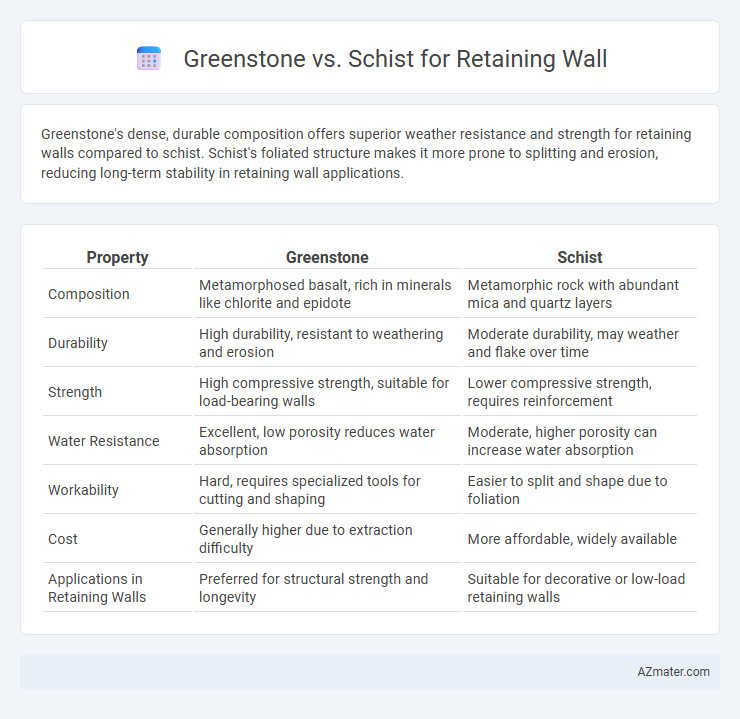Greenstone's dense, durable composition offers superior weather resistance and strength for retaining walls compared to schist. Schist's foliated structure makes it more prone to splitting and erosion, reducing long-term stability in retaining wall applications.
Table of Comparison
| Property | Greenstone | Schist |
|---|---|---|
| Composition | Metamorphosed basalt, rich in minerals like chlorite and epidote | Metamorphic rock with abundant mica and quartz layers |
| Durability | High durability, resistant to weathering and erosion | Moderate durability, may weather and flake over time |
| Strength | High compressive strength, suitable for load-bearing walls | Lower compressive strength, requires reinforcement |
| Water Resistance | Excellent, low porosity reduces water absorption | Moderate, higher porosity can increase water absorption |
| Workability | Hard, requires specialized tools for cutting and shaping | Easier to split and shape due to foliation |
| Cost | Generally higher due to extraction difficulty | More affordable, widely available |
| Applications in Retaining Walls | Preferred for structural strength and longevity | Suitable for decorative or low-load retaining walls |
Introduction to Retaining Wall Materials
Greenstone and schist are popular natural stone materials utilized in retaining wall construction due to their durability and aesthetic appeal. Greenstone, a dense and weather-resistant metamorphic rock, offers excellent structural strength, making it ideal for high-load applications. Schist, characterized by its foliated texture and varied mineral composition, provides enhanced flexibility in design and drainage properties, contributing to long-term wall stability.
Overview of Greenstone and Schist
Greenstone is a durable, fine-grained metamorphic rock formed from basalt, valued for its high compressive strength and resistance to weathering, making it ideal for retaining wall construction. Schist, characterized by its foliated texture and abundant mica content, offers moderate strength but lower resistance to moisture and freeze-thaw cycles, which can affect long-term stability. Comparing these materials, greenstone provides superior structural integrity and durability while schist may require additional treatment or reinforcement in retaining wall applications.
Geological Properties of Greenstone
Greenstone is a metamorphic rock characterized by its fine-grained texture and high durability, making it highly resistant to weathering and erosion compared to schist. Its composition primarily includes chlorite, actinolite, and epidote, which contribute to its toughness and low porosity, ideal for retaining wall stability. Unlike schist, which can exhibit pronounced foliation and weaker planes, greenstone's dense structure provides superior load-bearing capacity and long-term structural integrity in retaining wall applications.
Geological Properties of Schist
Schist, a metamorphic rock characterized by its foliated texture and abundant mica minerals, exhibits moderate to high durability and significant foliation planes that influence its mechanical strength and stability in retaining walls. Its anisotropic structure can lead to preferential weathering and potential structural weaknesses, requiring careful orientation during construction to optimize load-bearing capacities. Compared to Greenstone, Schist generally offers less resistance to erosion and fracturing, making geological assessment crucial for long-term performance in retaining wall applications.
Durability Comparison: Greenstone vs Schist
Greenstone exhibits superior durability compared to schist for retaining walls due to its dense, fine-grained structure and high resistance to weathering and abrasion. Schist, while aesthetically appealing with its foliated texture, is more prone to splitting and erosion under prolonged exposure to moisture and freeze-thaw cycles. Choosing Greenstone ensures enhanced structural integrity and longevity in retaining wall applications.
Aesthetic Appeal: Visual Differences
Greenstone offers a rich, deep green color with a smooth texture that brings a natural, polished aesthetic to retaining walls. Schist displays a varied, flaky appearance with metallic flakes and shades ranging from gray to bronze, creating a rugged, textured visual impact. These distinct color tones and surface textures influence the overall design style, with greenstone suited for sleek, modern looks and schist ideal for rustic, earthy settings.
Structural Strength and Stability
Greenstone exhibits high compressive strength and natural durability, making it an excellent choice for retaining walls requiring robust structural support. Schist, while visually appealing due to its foliated texture, tends to have lower structural strength and may be prone to splitting under heavy loads. For long-term stability and load-bearing capacity, greenstone is generally more reliable, providing superior resistance to weathering and pressure.
Installation and Workability
Greenstone offers superior workability for retaining wall installation due to its uniform texture and ease of cutting, allowing for precise fitting and faster assembly. Schist, with its foliated structure, can be more challenging to shape and install, often requiring additional labor and specialized tools to ensure stability. Choosing Greenstone typically results in a more efficient installation process and reduced overall project time.
Cost and Availability Analysis
Greenstone offers a more cost-effective option for retaining walls due to its widespread availability in quarry regions, reducing transportation expenses. Schist, while aesthetically appealing and durable, typically incurs higher costs driven by limited local availability and quarrying complexity. Evaluating project location and budget constraints is crucial to determine the most economical choice between greenstone and schist for retaining wall construction.
Environmental Impact and Sustainability
Greenstone offers a low environmental impact due to its natural durability and minimal processing requirements, reducing energy consumption and carbon emissions during production. Schist, while aesthetically appealing, typically demands more intensive quarrying and processing, leading to higher environmental costs. Choosing greenstone for retaining walls supports sustainability by enhancing local resource use and promoting longer-lasting structures with less ecological disturbance.

Infographic: Greenstone vs Schist for Retaining Wall
 azmater.com
azmater.com